Analyzing Corporate Social Responsibility of Australian Supermarkets
VerifiedAdded on 2023/06/12
|13
|3281
|321
Literature Review
AI Summary
This literature review delves into the corporate social responsibility (CSR) practices of leading supermarkets in Australia, examining their impact on both the businesses themselves and the wider society. It identifies the present CSR initiatives undertaken by these supermarkets, including ethical sourcing policies and community engagement programs, while also highlighting associated issues such as wage theft and unsustainable environmental practices. The review analyzes the importance of CSR in enhancing corporate image, attracting talent, and fostering positive consumer sentiment. A literature gap is identified regarding the quantifiable impacts of CSR activities, leading to research questions exploring the influence of CSR on Australian supermarkets, their main responsibilities, associated issues, and overall societal impact. The research employs a qualitative, exploratory design, utilizing data from supermarket reports, websites, and interviews, analyzed via NVIVO software. Desklib provides access to similar solved assignments and study resources for students.
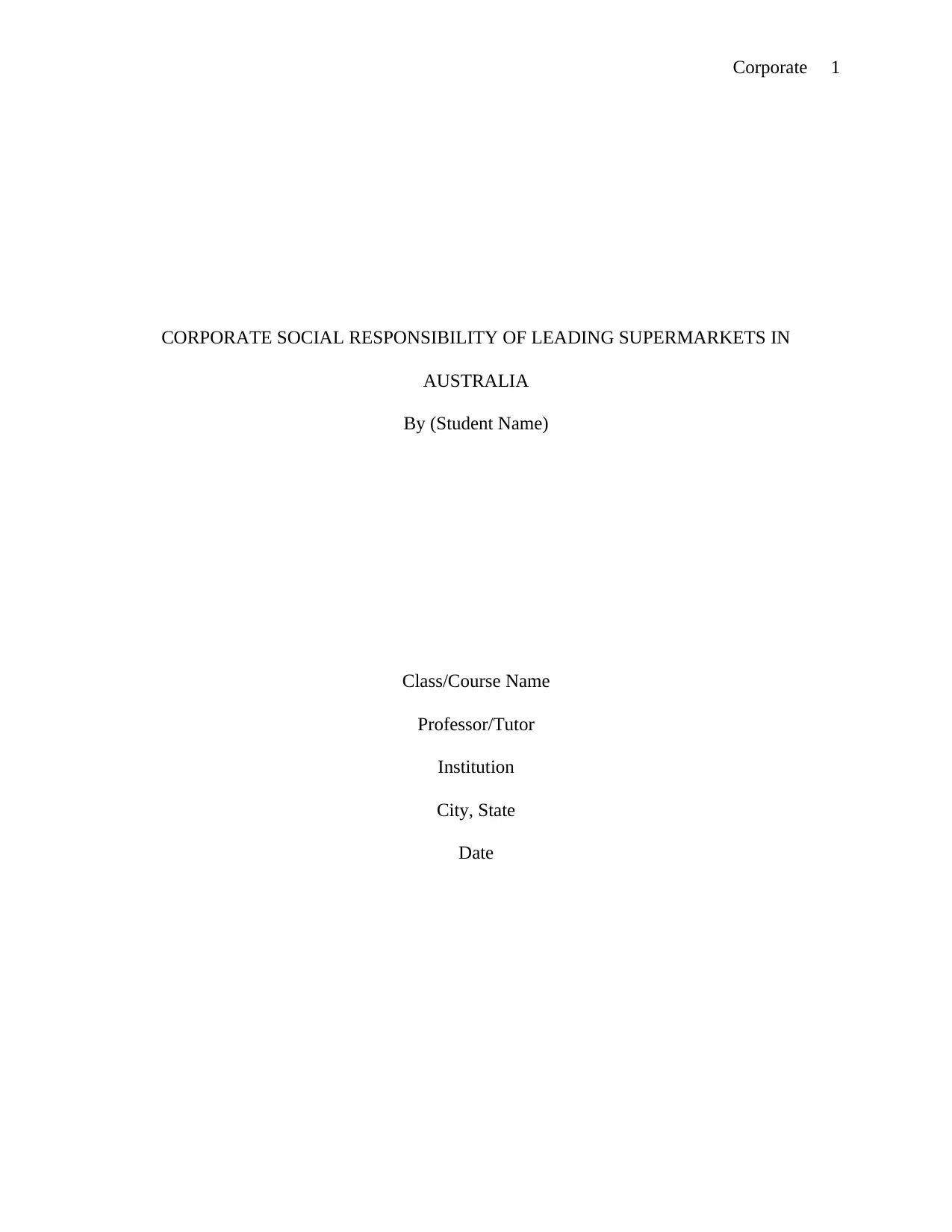
Corporate 1
CORPORATE SOCIAL RESPONSIBILITY OF LEADING SUPERMARKETS IN
AUSTRALIA
By (Student Name)
Class/Course Name
Professor/Tutor
Institution
City, State
Date
CORPORATE SOCIAL RESPONSIBILITY OF LEADING SUPERMARKETS IN
AUSTRALIA
By (Student Name)
Class/Course Name
Professor/Tutor
Institution
City, State
Date
Paraphrase This Document
Need a fresh take? Get an instant paraphrase of this document with our AI Paraphraser
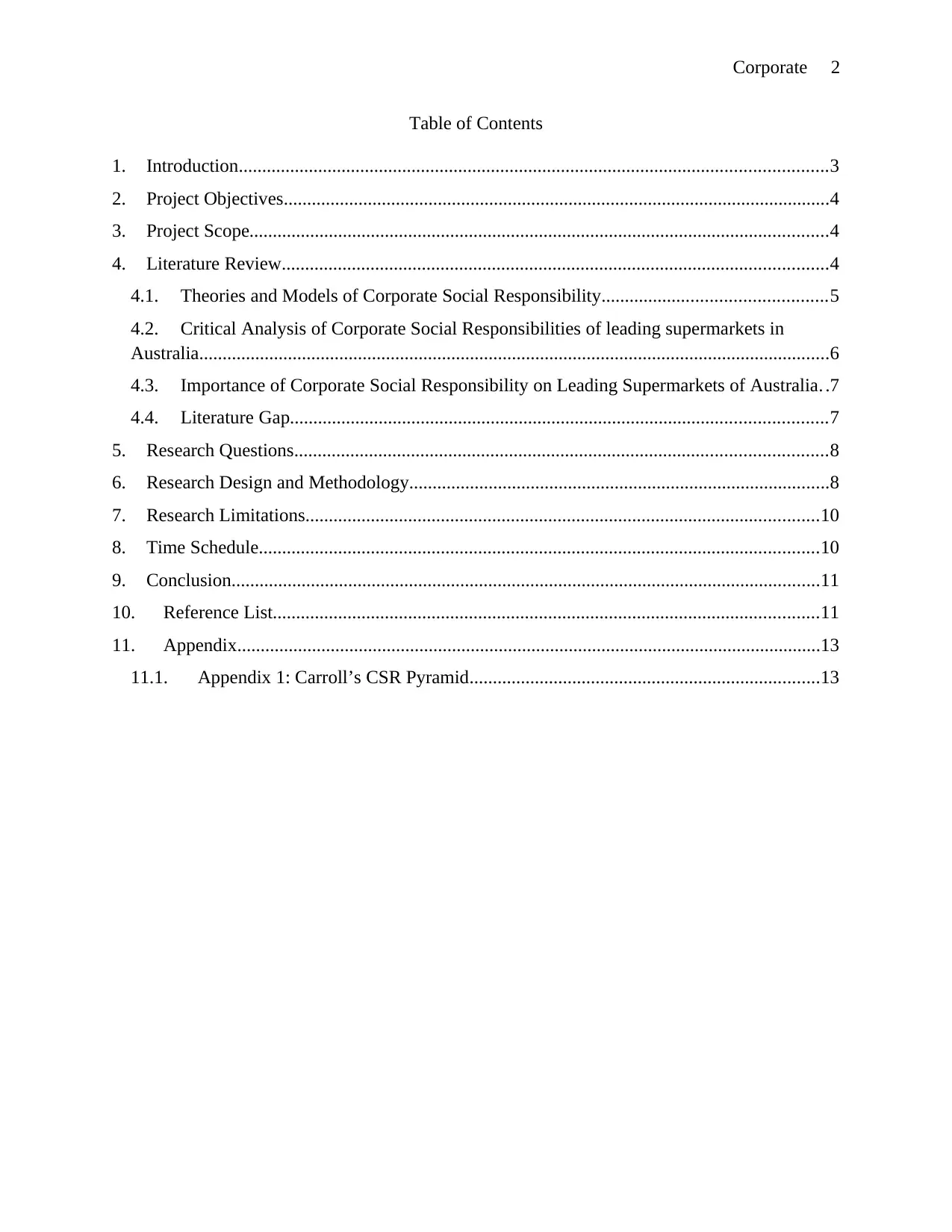
Corporate 2
Table of Contents
1. Introduction..............................................................................................................................3
2. Project Objectives.....................................................................................................................4
3. Project Scope............................................................................................................................4
4. Literature Review.....................................................................................................................4
4.1. Theories and Models of Corporate Social Responsibility................................................5
4.2. Critical Analysis of Corporate Social Responsibilities of leading supermarkets in
Australia.......................................................................................................................................6
4.3. Importance of Corporate Social Responsibility on Leading Supermarkets of Australia. .7
4.4. Literature Gap...................................................................................................................7
5. Research Questions..................................................................................................................8
6. Research Design and Methodology..........................................................................................8
7. Research Limitations..............................................................................................................10
8. Time Schedule........................................................................................................................10
9. Conclusion..............................................................................................................................11
10. Reference List.....................................................................................................................11
11. Appendix.............................................................................................................................13
11.1. Appendix 1: Carroll’s CSR Pyramid...........................................................................13
Table of Contents
1. Introduction..............................................................................................................................3
2. Project Objectives.....................................................................................................................4
3. Project Scope............................................................................................................................4
4. Literature Review.....................................................................................................................4
4.1. Theories and Models of Corporate Social Responsibility................................................5
4.2. Critical Analysis of Corporate Social Responsibilities of leading supermarkets in
Australia.......................................................................................................................................6
4.3. Importance of Corporate Social Responsibility on Leading Supermarkets of Australia. .7
4.4. Literature Gap...................................................................................................................7
5. Research Questions..................................................................................................................8
6. Research Design and Methodology..........................................................................................8
7. Research Limitations..............................................................................................................10
8. Time Schedule........................................................................................................................10
9. Conclusion..............................................................................................................................11
10. Reference List.....................................................................................................................11
11. Appendix.............................................................................................................................13
11.1. Appendix 1: Carroll’s CSR Pyramid...........................................................................13
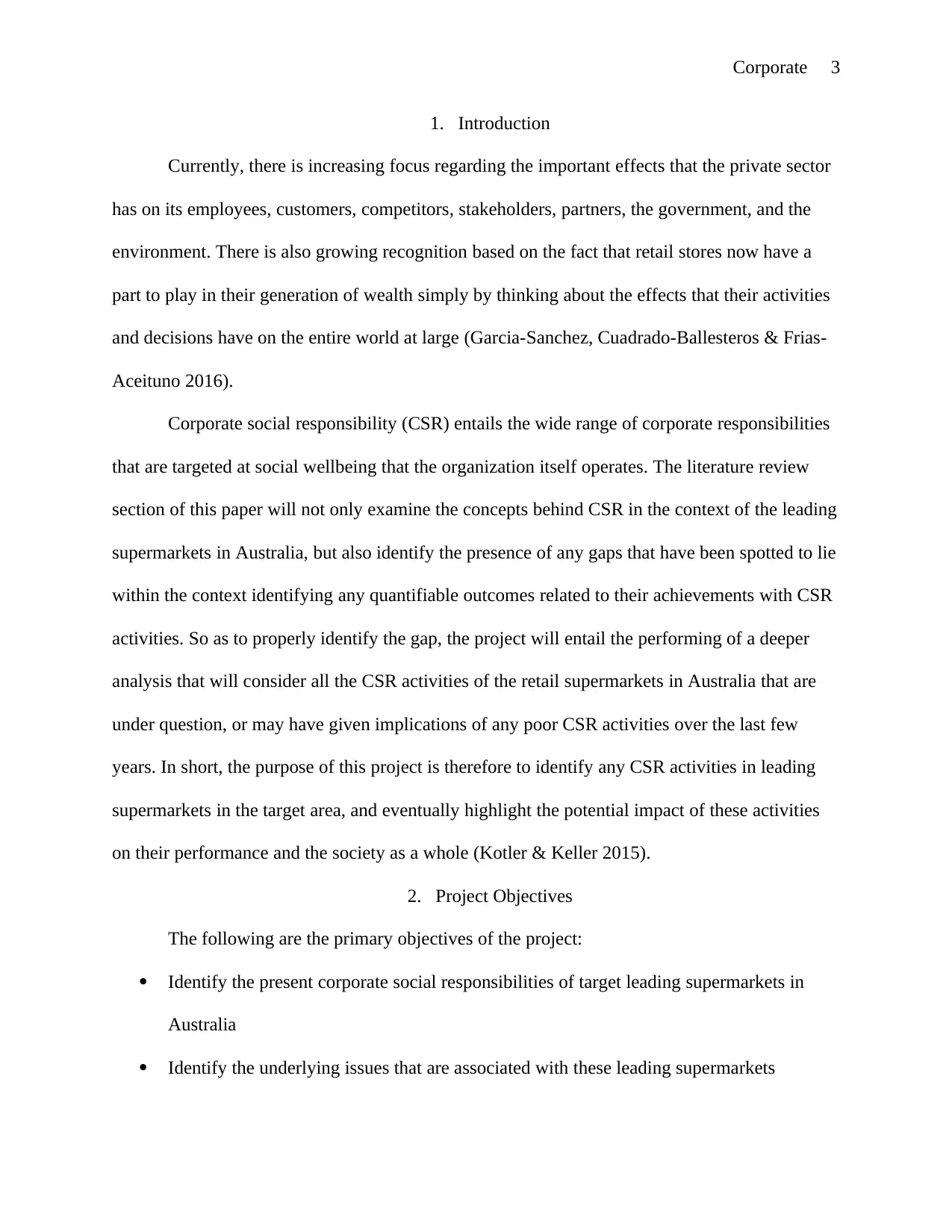
Corporate 3
1. Introduction
Currently, there is increasing focus regarding the important effects that the private sector
has on its employees, customers, competitors, stakeholders, partners, the government, and the
environment. There is also growing recognition based on the fact that retail stores now have a
part to play in their generation of wealth simply by thinking about the effects that their activities
and decisions have on the entire world at large (Garcia-Sanchez, Cuadrado-Ballesteros & Frias-
Aceituno 2016).
Corporate social responsibility (CSR) entails the wide range of corporate responsibilities
that are targeted at social wellbeing that the organization itself operates. The literature review
section of this paper will not only examine the concepts behind CSR in the context of the leading
supermarkets in Australia, but also identify the presence of any gaps that have been spotted to lie
within the context identifying any quantifiable outcomes related to their achievements with CSR
activities. So as to properly identify the gap, the project will entail the performing of a deeper
analysis that will consider all the CSR activities of the retail supermarkets in Australia that are
under question, or may have given implications of any poor CSR activities over the last few
years. In short, the purpose of this project is therefore to identify any CSR activities in leading
supermarkets in the target area, and eventually highlight the potential impact of these activities
on their performance and the society as a whole (Kotler & Keller 2015).
2. Project Objectives
The following are the primary objectives of the project:
Identify the present corporate social responsibilities of target leading supermarkets in
Australia
Identify the underlying issues that are associated with these leading supermarkets
1. Introduction
Currently, there is increasing focus regarding the important effects that the private sector
has on its employees, customers, competitors, stakeholders, partners, the government, and the
environment. There is also growing recognition based on the fact that retail stores now have a
part to play in their generation of wealth simply by thinking about the effects that their activities
and decisions have on the entire world at large (Garcia-Sanchez, Cuadrado-Ballesteros & Frias-
Aceituno 2016).
Corporate social responsibility (CSR) entails the wide range of corporate responsibilities
that are targeted at social wellbeing that the organization itself operates. The literature review
section of this paper will not only examine the concepts behind CSR in the context of the leading
supermarkets in Australia, but also identify the presence of any gaps that have been spotted to lie
within the context identifying any quantifiable outcomes related to their achievements with CSR
activities. So as to properly identify the gap, the project will entail the performing of a deeper
analysis that will consider all the CSR activities of the retail supermarkets in Australia that are
under question, or may have given implications of any poor CSR activities over the last few
years. In short, the purpose of this project is therefore to identify any CSR activities in leading
supermarkets in the target area, and eventually highlight the potential impact of these activities
on their performance and the society as a whole (Kotler & Keller 2015).
2. Project Objectives
The following are the primary objectives of the project:
Identify the present corporate social responsibilities of target leading supermarkets in
Australia
Identify the underlying issues that are associated with these leading supermarkets
⊘ This is a preview!⊘
Do you want full access?
Subscribe today to unlock all pages.

Trusted by 1+ million students worldwide
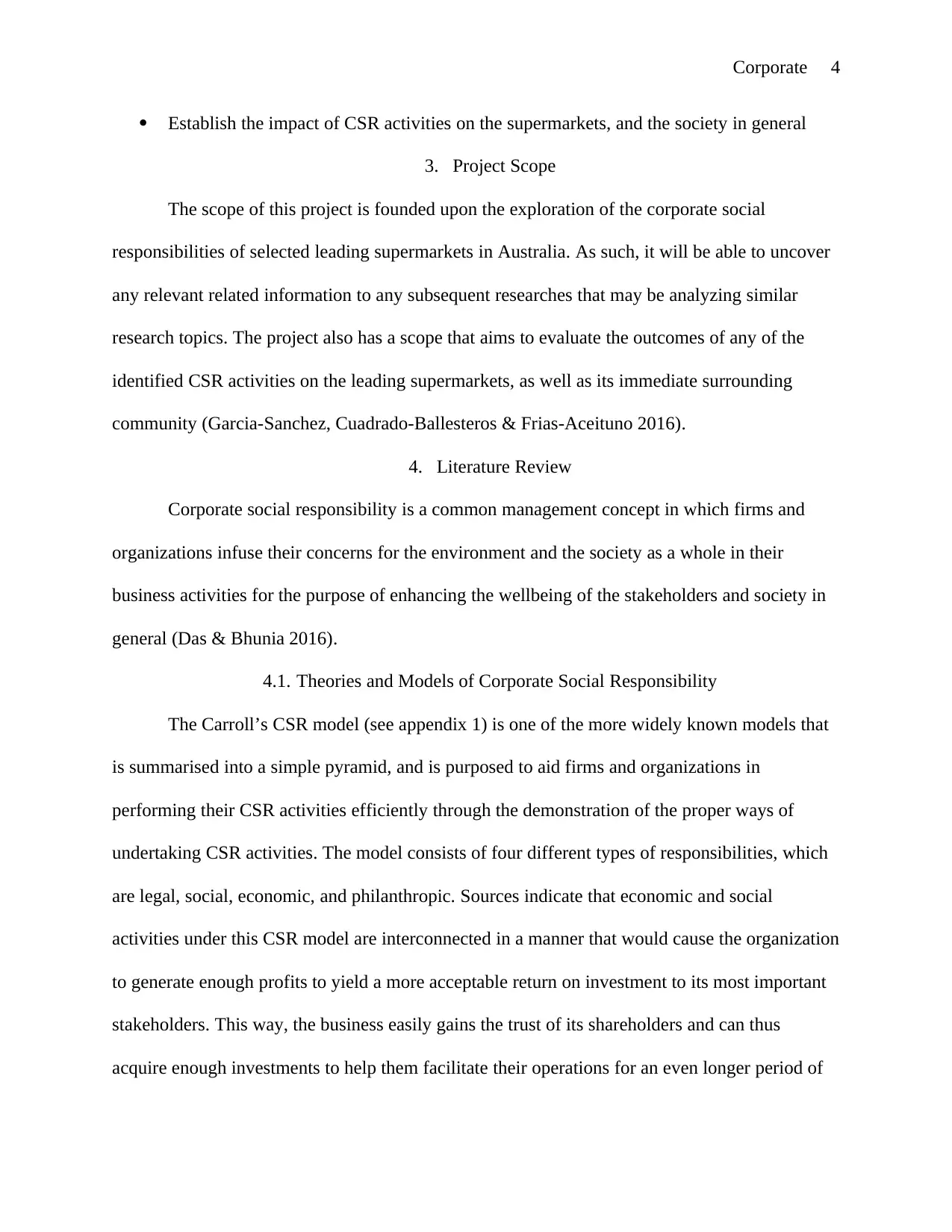
Corporate 4
Establish the impact of CSR activities on the supermarkets, and the society in general
3. Project Scope
The scope of this project is founded upon the exploration of the corporate social
responsibilities of selected leading supermarkets in Australia. As such, it will be able to uncover
any relevant related information to any subsequent researches that may be analyzing similar
research topics. The project also has a scope that aims to evaluate the outcomes of any of the
identified CSR activities on the leading supermarkets, as well as its immediate surrounding
community (Garcia-Sanchez, Cuadrado-Ballesteros & Frias-Aceituno 2016).
4. Literature Review
Corporate social responsibility is a common management concept in which firms and
organizations infuse their concerns for the environment and the society as a whole in their
business activities for the purpose of enhancing the wellbeing of the stakeholders and society in
general (Das & Bhunia 2016).
4.1. Theories and Models of Corporate Social Responsibility
The Carroll’s CSR model (see appendix 1) is one of the more widely known models that
is summarised into a simple pyramid, and is purposed to aid firms and organizations in
performing their CSR activities efficiently through the demonstration of the proper ways of
undertaking CSR activities. The model consists of four different types of responsibilities, which
are legal, social, economic, and philanthropic. Sources indicate that economic and social
activities under this CSR model are interconnected in a manner that would cause the organization
to generate enough profits to yield a more acceptable return on investment to its most important
stakeholders. This way, the business easily gains the trust of its shareholders and can thus
acquire enough investments to help them facilitate their operations for an even longer period of
Establish the impact of CSR activities on the supermarkets, and the society in general
3. Project Scope
The scope of this project is founded upon the exploration of the corporate social
responsibilities of selected leading supermarkets in Australia. As such, it will be able to uncover
any relevant related information to any subsequent researches that may be analyzing similar
research topics. The project also has a scope that aims to evaluate the outcomes of any of the
identified CSR activities on the leading supermarkets, as well as its immediate surrounding
community (Garcia-Sanchez, Cuadrado-Ballesteros & Frias-Aceituno 2016).
4. Literature Review
Corporate social responsibility is a common management concept in which firms and
organizations infuse their concerns for the environment and the society as a whole in their
business activities for the purpose of enhancing the wellbeing of the stakeholders and society in
general (Das & Bhunia 2016).
4.1. Theories and Models of Corporate Social Responsibility
The Carroll’s CSR model (see appendix 1) is one of the more widely known models that
is summarised into a simple pyramid, and is purposed to aid firms and organizations in
performing their CSR activities efficiently through the demonstration of the proper ways of
undertaking CSR activities. The model consists of four different types of responsibilities, which
are legal, social, economic, and philanthropic. Sources indicate that economic and social
activities under this CSR model are interconnected in a manner that would cause the organization
to generate enough profits to yield a more acceptable return on investment to its most important
stakeholders. This way, the business easily gains the trust of its shareholders and can thus
acquire enough investments to help them facilitate their operations for an even longer period of
Paraphrase This Document
Need a fresh take? Get an instant paraphrase of this document with our AI Paraphraser
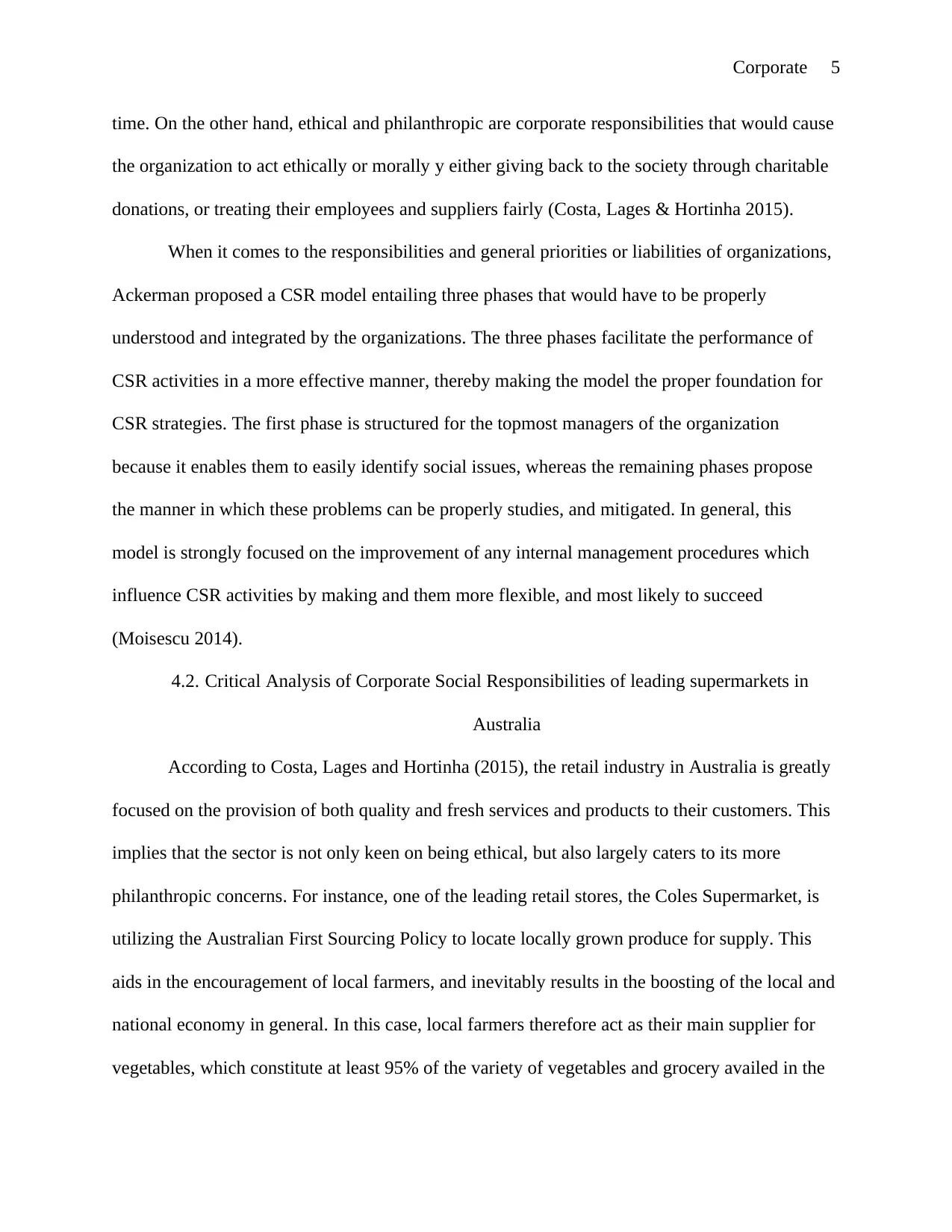
Corporate 5
time. On the other hand, ethical and philanthropic are corporate responsibilities that would cause
the organization to act ethically or morally y either giving back to the society through charitable
donations, or treating their employees and suppliers fairly (Costa, Lages & Hortinha 2015).
When it comes to the responsibilities and general priorities or liabilities of organizations,
Ackerman proposed a CSR model entailing three phases that would have to be properly
understood and integrated by the organizations. The three phases facilitate the performance of
CSR activities in a more effective manner, thereby making the model the proper foundation for
CSR strategies. The first phase is structured for the topmost managers of the organization
because it enables them to easily identify social issues, whereas the remaining phases propose
the manner in which these problems can be properly studies, and mitigated. In general, this
model is strongly focused on the improvement of any internal management procedures which
influence CSR activities by making and them more flexible, and most likely to succeed
(Moisescu 2014).
4.2. Critical Analysis of Corporate Social Responsibilities of leading supermarkets in
Australia
According to Costa, Lages and Hortinha (2015), the retail industry in Australia is greatly
focused on the provision of both quality and fresh services and products to their customers. This
implies that the sector is not only keen on being ethical, but also largely caters to its more
philanthropic concerns. For instance, one of the leading retail stores, the Coles Supermarket, is
utilizing the Australian First Sourcing Policy to locate locally grown produce for supply. This
aids in the encouragement of local farmers, and inevitably results in the boosting of the local and
national economy in general. In this case, local farmers therefore act as their main supplier for
vegetables, which constitute at least 95% of the variety of vegetables and grocery availed in the
time. On the other hand, ethical and philanthropic are corporate responsibilities that would cause
the organization to act ethically or morally y either giving back to the society through charitable
donations, or treating their employees and suppliers fairly (Costa, Lages & Hortinha 2015).
When it comes to the responsibilities and general priorities or liabilities of organizations,
Ackerman proposed a CSR model entailing three phases that would have to be properly
understood and integrated by the organizations. The three phases facilitate the performance of
CSR activities in a more effective manner, thereby making the model the proper foundation for
CSR strategies. The first phase is structured for the topmost managers of the organization
because it enables them to easily identify social issues, whereas the remaining phases propose
the manner in which these problems can be properly studies, and mitigated. In general, this
model is strongly focused on the improvement of any internal management procedures which
influence CSR activities by making and them more flexible, and most likely to succeed
(Moisescu 2014).
4.2. Critical Analysis of Corporate Social Responsibilities of leading supermarkets in
Australia
According to Costa, Lages and Hortinha (2015), the retail industry in Australia is greatly
focused on the provision of both quality and fresh services and products to their customers. This
implies that the sector is not only keen on being ethical, but also largely caters to its more
philanthropic concerns. For instance, one of the leading retail stores, the Coles Supermarket, is
utilizing the Australian First Sourcing Policy to locate locally grown produce for supply. This
aids in the encouragement of local farmers, and inevitably results in the boosting of the local and
national economy in general. In this case, local farmers therefore act as their main supplier for
vegetables, which constitute at least 95% of the variety of vegetables and grocery availed in the
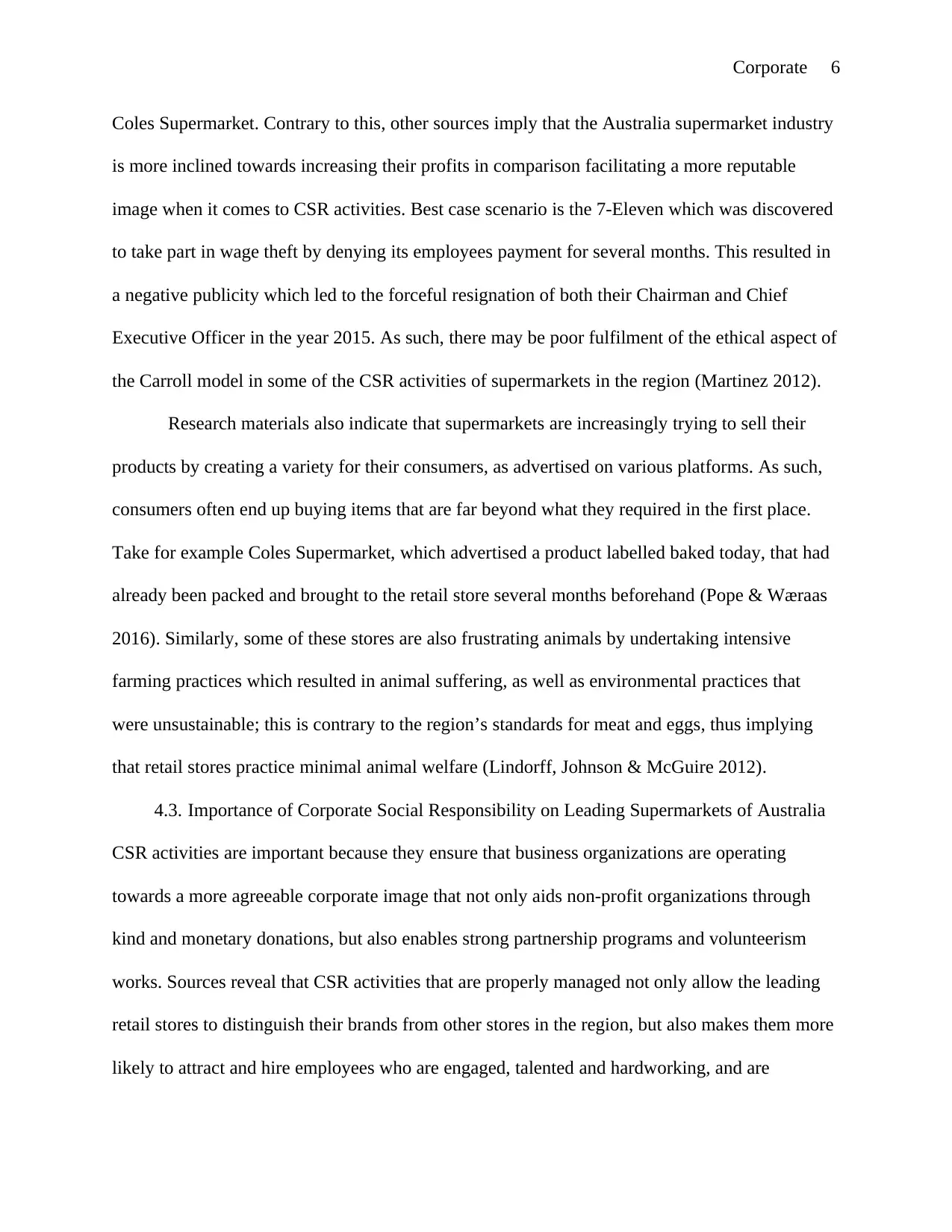
Corporate 6
Coles Supermarket. Contrary to this, other sources imply that the Australia supermarket industry
is more inclined towards increasing their profits in comparison facilitating a more reputable
image when it comes to CSR activities. Best case scenario is the 7-Eleven which was discovered
to take part in wage theft by denying its employees payment for several months. This resulted in
a negative publicity which led to the forceful resignation of both their Chairman and Chief
Executive Officer in the year 2015. As such, there may be poor fulfilment of the ethical aspect of
the Carroll model in some of the CSR activities of supermarkets in the region (Martinez 2012).
Research materials also indicate that supermarkets are increasingly trying to sell their
products by creating a variety for their consumers, as advertised on various platforms. As such,
consumers often end up buying items that are far beyond what they required in the first place.
Take for example Coles Supermarket, which advertised a product labelled baked today, that had
already been packed and brought to the retail store several months beforehand (Pope & Wæraas
2016). Similarly, some of these stores are also frustrating animals by undertaking intensive
farming practices which resulted in animal suffering, as well as environmental practices that
were unsustainable; this is contrary to the region’s standards for meat and eggs, thus implying
that retail stores practice minimal animal welfare (Lindorff, Johnson & McGuire 2012).
4.3. Importance of Corporate Social Responsibility on Leading Supermarkets of Australia
CSR activities are important because they ensure that business organizations are operating
towards a more agreeable corporate image that not only aids non-profit organizations through
kind and monetary donations, but also enables strong partnership programs and volunteerism
works. Sources reveal that CSR activities that are properly managed not only allow the leading
retail stores to distinguish their brands from other stores in the region, but also makes them more
likely to attract and hire employees who are engaged, talented and hardworking, and are
Coles Supermarket. Contrary to this, other sources imply that the Australia supermarket industry
is more inclined towards increasing their profits in comparison facilitating a more reputable
image when it comes to CSR activities. Best case scenario is the 7-Eleven which was discovered
to take part in wage theft by denying its employees payment for several months. This resulted in
a negative publicity which led to the forceful resignation of both their Chairman and Chief
Executive Officer in the year 2015. As such, there may be poor fulfilment of the ethical aspect of
the Carroll model in some of the CSR activities of supermarkets in the region (Martinez 2012).
Research materials also indicate that supermarkets are increasingly trying to sell their
products by creating a variety for their consumers, as advertised on various platforms. As such,
consumers often end up buying items that are far beyond what they required in the first place.
Take for example Coles Supermarket, which advertised a product labelled baked today, that had
already been packed and brought to the retail store several months beforehand (Pope & Wæraas
2016). Similarly, some of these stores are also frustrating animals by undertaking intensive
farming practices which resulted in animal suffering, as well as environmental practices that
were unsustainable; this is contrary to the region’s standards for meat and eggs, thus implying
that retail stores practice minimal animal welfare (Lindorff, Johnson & McGuire 2012).
4.3. Importance of Corporate Social Responsibility on Leading Supermarkets of Australia
CSR activities are important because they ensure that business organizations are operating
towards a more agreeable corporate image that not only aids non-profit organizations through
kind and monetary donations, but also enables strong partnership programs and volunteerism
works. Sources reveal that CSR activities that are properly managed not only allow the leading
retail stores to distinguish their brands from other stores in the region, but also makes them more
likely to attract and hire employees who are engaged, talented and hardworking, and are
⊘ This is a preview!⊘
Do you want full access?
Subscribe today to unlock all pages.

Trusted by 1+ million students worldwide
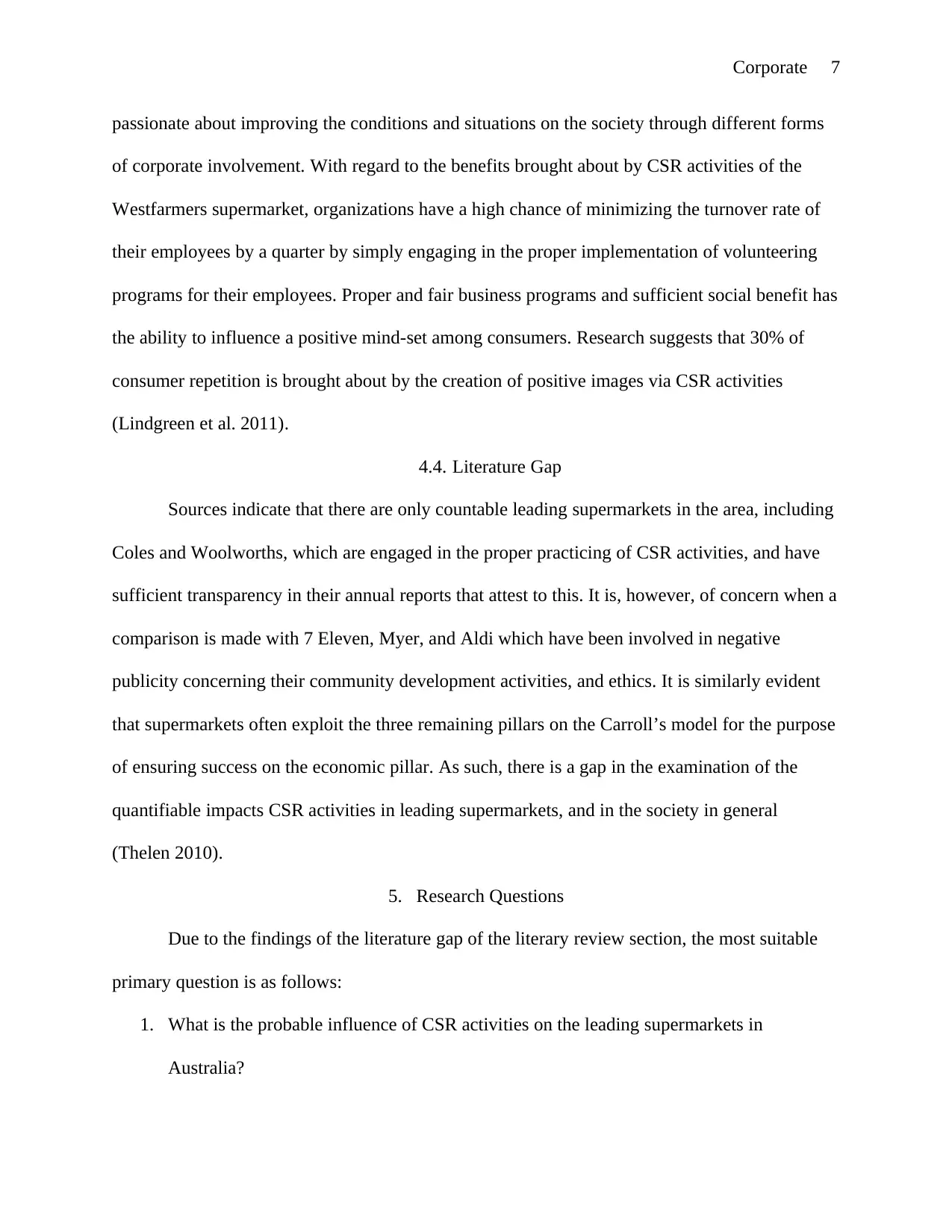
Corporate 7
passionate about improving the conditions and situations on the society through different forms
of corporate involvement. With regard to the benefits brought about by CSR activities of the
Westfarmers supermarket, organizations have a high chance of minimizing the turnover rate of
their employees by a quarter by simply engaging in the proper implementation of volunteering
programs for their employees. Proper and fair business programs and sufficient social benefit has
the ability to influence a positive mind-set among consumers. Research suggests that 30% of
consumer repetition is brought about by the creation of positive images via CSR activities
(Lindgreen et al. 2011).
4.4. Literature Gap
Sources indicate that there are only countable leading supermarkets in the area, including
Coles and Woolworths, which are engaged in the proper practicing of CSR activities, and have
sufficient transparency in their annual reports that attest to this. It is, however, of concern when a
comparison is made with 7 Eleven, Myer, and Aldi which have been involved in negative
publicity concerning their community development activities, and ethics. It is similarly evident
that supermarkets often exploit the three remaining pillars on the Carroll’s model for the purpose
of ensuring success on the economic pillar. As such, there is a gap in the examination of the
quantifiable impacts CSR activities in leading supermarkets, and in the society in general
(Thelen 2010).
5. Research Questions
Due to the findings of the literature gap of the literary review section, the most suitable
primary question is as follows:
1. What is the probable influence of CSR activities on the leading supermarkets in
Australia?
passionate about improving the conditions and situations on the society through different forms
of corporate involvement. With regard to the benefits brought about by CSR activities of the
Westfarmers supermarket, organizations have a high chance of minimizing the turnover rate of
their employees by a quarter by simply engaging in the proper implementation of volunteering
programs for their employees. Proper and fair business programs and sufficient social benefit has
the ability to influence a positive mind-set among consumers. Research suggests that 30% of
consumer repetition is brought about by the creation of positive images via CSR activities
(Lindgreen et al. 2011).
4.4. Literature Gap
Sources indicate that there are only countable leading supermarkets in the area, including
Coles and Woolworths, which are engaged in the proper practicing of CSR activities, and have
sufficient transparency in their annual reports that attest to this. It is, however, of concern when a
comparison is made with 7 Eleven, Myer, and Aldi which have been involved in negative
publicity concerning their community development activities, and ethics. It is similarly evident
that supermarkets often exploit the three remaining pillars on the Carroll’s model for the purpose
of ensuring success on the economic pillar. As such, there is a gap in the examination of the
quantifiable impacts CSR activities in leading supermarkets, and in the society in general
(Thelen 2010).
5. Research Questions
Due to the findings of the literature gap of the literary review section, the most suitable
primary question is as follows:
1. What is the probable influence of CSR activities on the leading supermarkets in
Australia?
Paraphrase This Document
Need a fresh take? Get an instant paraphrase of this document with our AI Paraphraser
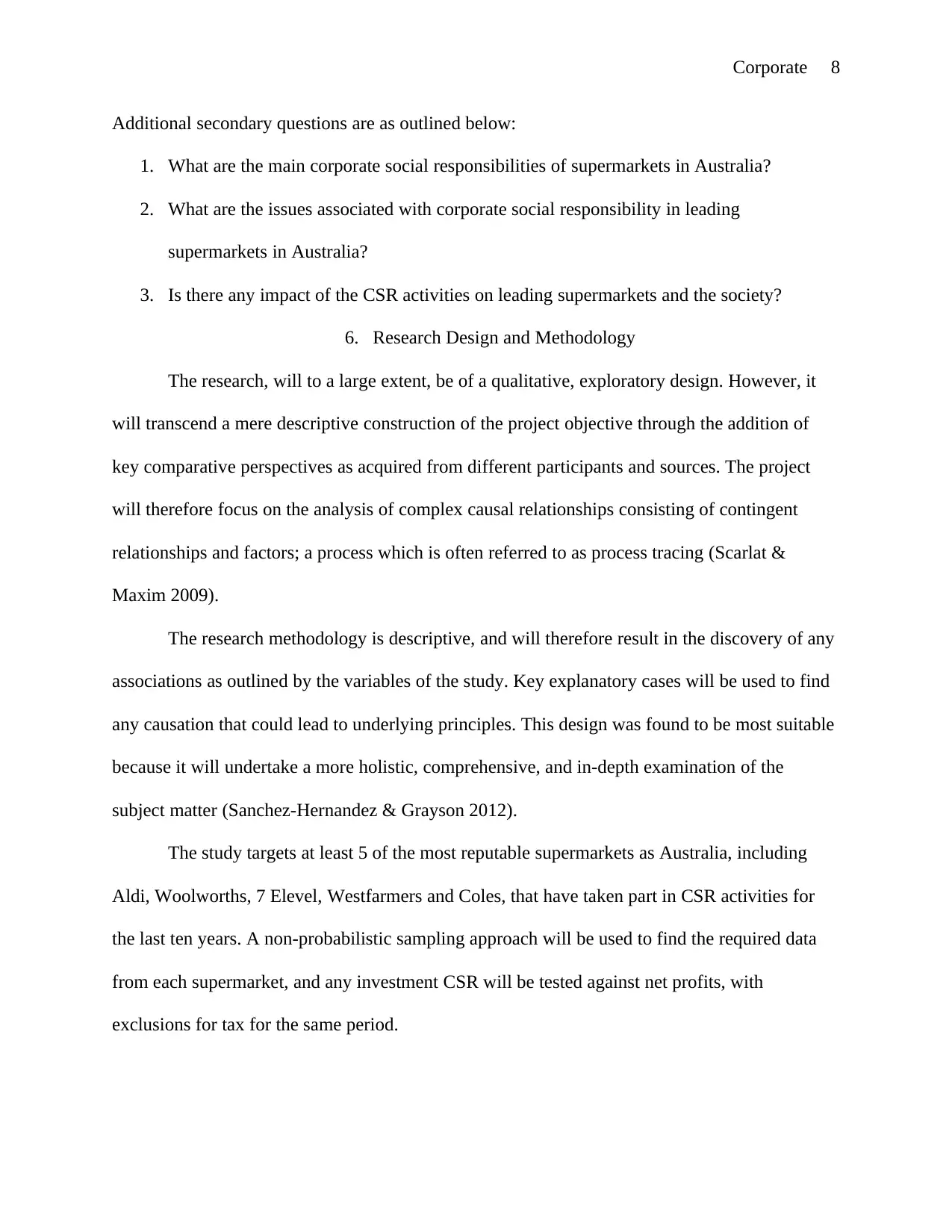
Corporate 8
Additional secondary questions are as outlined below:
1. What are the main corporate social responsibilities of supermarkets in Australia?
2. What are the issues associated with corporate social responsibility in leading
supermarkets in Australia?
3. Is there any impact of the CSR activities on leading supermarkets and the society?
6. Research Design and Methodology
The research, will to a large extent, be of a qualitative, exploratory design. However, it
will transcend a mere descriptive construction of the project objective through the addition of
key comparative perspectives as acquired from different participants and sources. The project
will therefore focus on the analysis of complex causal relationships consisting of contingent
relationships and factors; a process which is often referred to as process tracing (Scarlat &
Maxim 2009).
The research methodology is descriptive, and will therefore result in the discovery of any
associations as outlined by the variables of the study. Key explanatory cases will be used to find
any causation that could lead to underlying principles. This design was found to be most suitable
because it will undertake a more holistic, comprehensive, and in-depth examination of the
subject matter (Sanchez-Hernandez & Grayson 2012).
The study targets at least 5 of the most reputable supermarkets as Australia, including
Aldi, Woolworths, 7 Elevel, Westfarmers and Coles, that have taken part in CSR activities for
the last ten years. A non-probabilistic sampling approach will be used to find the required data
from each supermarket, and any investment CSR will be tested against net profits, with
exclusions for tax for the same period.
Additional secondary questions are as outlined below:
1. What are the main corporate social responsibilities of supermarkets in Australia?
2. What are the issues associated with corporate social responsibility in leading
supermarkets in Australia?
3. Is there any impact of the CSR activities on leading supermarkets and the society?
6. Research Design and Methodology
The research, will to a large extent, be of a qualitative, exploratory design. However, it
will transcend a mere descriptive construction of the project objective through the addition of
key comparative perspectives as acquired from different participants and sources. The project
will therefore focus on the analysis of complex causal relationships consisting of contingent
relationships and factors; a process which is often referred to as process tracing (Scarlat &
Maxim 2009).
The research methodology is descriptive, and will therefore result in the discovery of any
associations as outlined by the variables of the study. Key explanatory cases will be used to find
any causation that could lead to underlying principles. This design was found to be most suitable
because it will undertake a more holistic, comprehensive, and in-depth examination of the
subject matter (Sanchez-Hernandez & Grayson 2012).
The study targets at least 5 of the most reputable supermarkets as Australia, including
Aldi, Woolworths, 7 Elevel, Westfarmers and Coles, that have taken part in CSR activities for
the last ten years. A non-probabilistic sampling approach will be used to find the required data
from each supermarket, and any investment CSR will be tested against net profits, with
exclusions for tax for the same period.
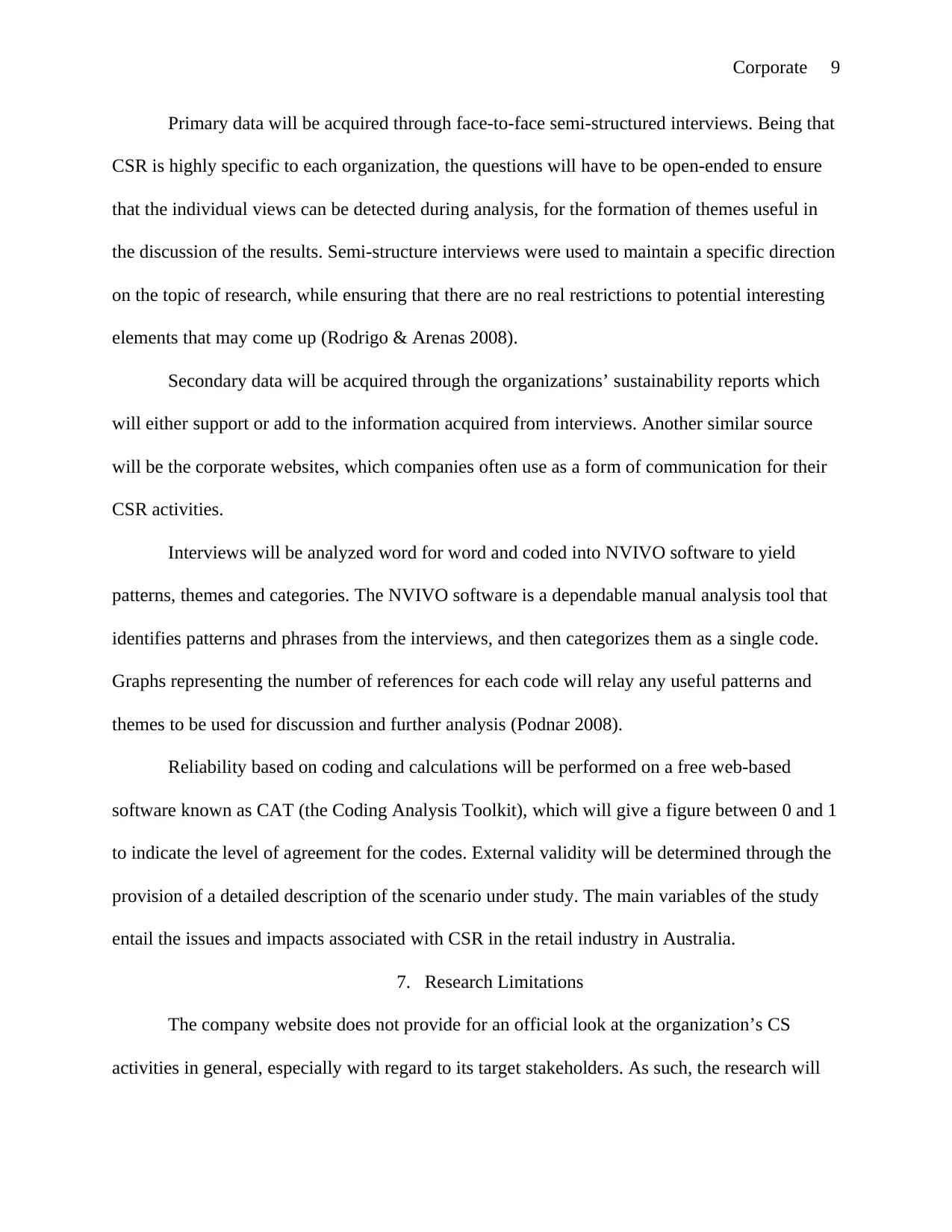
Corporate 9
Primary data will be acquired through face-to-face semi-structured interviews. Being that
CSR is highly specific to each organization, the questions will have to be open-ended to ensure
that the individual views can be detected during analysis, for the formation of themes useful in
the discussion of the results. Semi-structure interviews were used to maintain a specific direction
on the topic of research, while ensuring that there are no real restrictions to potential interesting
elements that may come up (Rodrigo & Arenas 2008).
Secondary data will be acquired through the organizations’ sustainability reports which
will either support or add to the information acquired from interviews. Another similar source
will be the corporate websites, which companies often use as a form of communication for their
CSR activities.
Interviews will be analyzed word for word and coded into NVIVO software to yield
patterns, themes and categories. The NVIVO software is a dependable manual analysis tool that
identifies patterns and phrases from the interviews, and then categorizes them as a single code.
Graphs representing the number of references for each code will relay any useful patterns and
themes to be used for discussion and further analysis (Podnar 2008).
Reliability based on coding and calculations will be performed on a free web-based
software known as CAT (the Coding Analysis Toolkit), which will give a figure between 0 and 1
to indicate the level of agreement for the codes. External validity will be determined through the
provision of a detailed description of the scenario under study. The main variables of the study
entail the issues and impacts associated with CSR in the retail industry in Australia.
7. Research Limitations
The company website does not provide for an official look at the organization’s CS
activities in general, especially with regard to its target stakeholders. As such, the research will
Primary data will be acquired through face-to-face semi-structured interviews. Being that
CSR is highly specific to each organization, the questions will have to be open-ended to ensure
that the individual views can be detected during analysis, for the formation of themes useful in
the discussion of the results. Semi-structure interviews were used to maintain a specific direction
on the topic of research, while ensuring that there are no real restrictions to potential interesting
elements that may come up (Rodrigo & Arenas 2008).
Secondary data will be acquired through the organizations’ sustainability reports which
will either support or add to the information acquired from interviews. Another similar source
will be the corporate websites, which companies often use as a form of communication for their
CSR activities.
Interviews will be analyzed word for word and coded into NVIVO software to yield
patterns, themes and categories. The NVIVO software is a dependable manual analysis tool that
identifies patterns and phrases from the interviews, and then categorizes them as a single code.
Graphs representing the number of references for each code will relay any useful patterns and
themes to be used for discussion and further analysis (Podnar 2008).
Reliability based on coding and calculations will be performed on a free web-based
software known as CAT (the Coding Analysis Toolkit), which will give a figure between 0 and 1
to indicate the level of agreement for the codes. External validity will be determined through the
provision of a detailed description of the scenario under study. The main variables of the study
entail the issues and impacts associated with CSR in the retail industry in Australia.
7. Research Limitations
The company website does not provide for an official look at the organization’s CS
activities in general, especially with regard to its target stakeholders. As such, the research will
⊘ This is a preview!⊘
Do you want full access?
Subscribe today to unlock all pages.

Trusted by 1+ million students worldwide
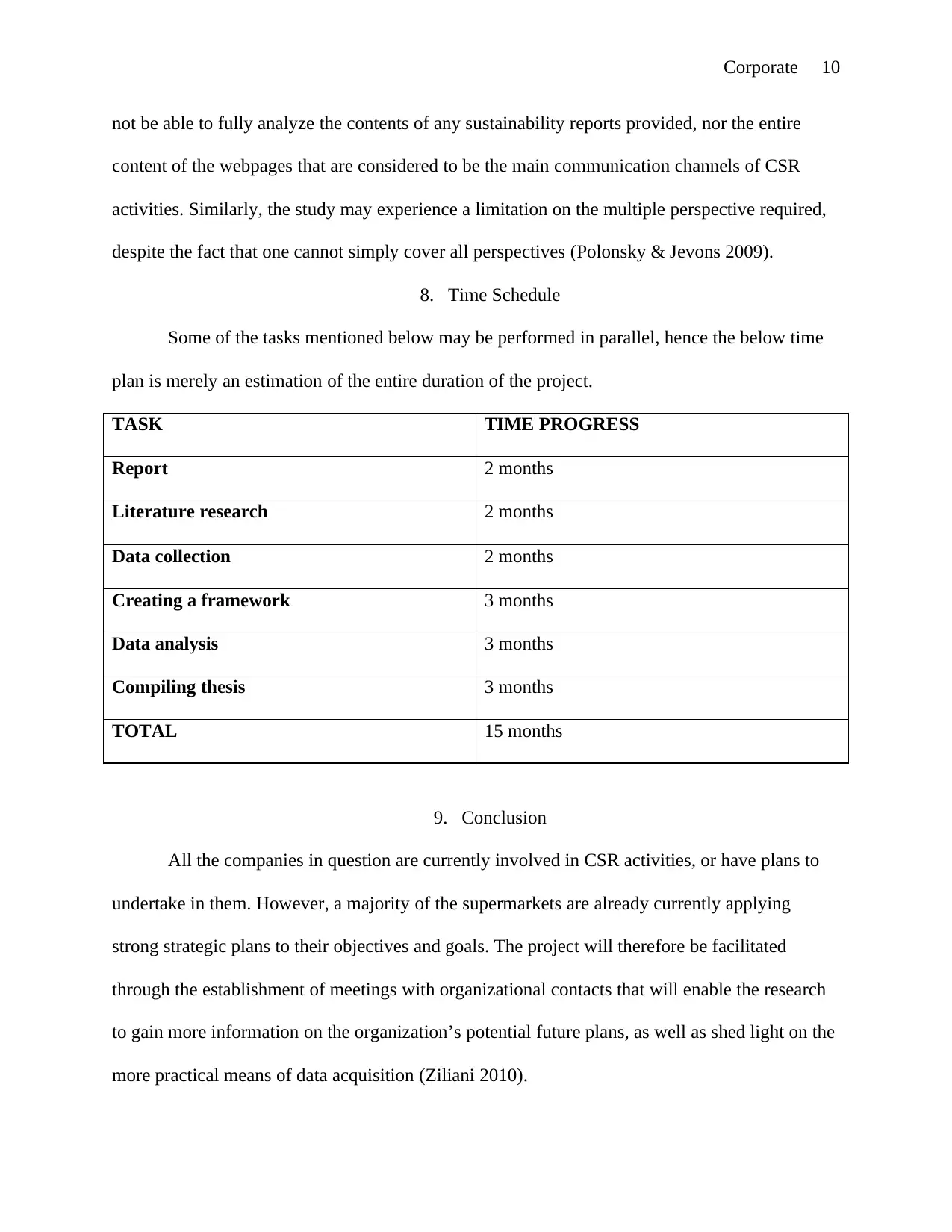
Corporate 10
not be able to fully analyze the contents of any sustainability reports provided, nor the entire
content of the webpages that are considered to be the main communication channels of CSR
activities. Similarly, the study may experience a limitation on the multiple perspective required,
despite the fact that one cannot simply cover all perspectives (Polonsky & Jevons 2009).
8. Time Schedule
Some of the tasks mentioned below may be performed in parallel, hence the below time
plan is merely an estimation of the entire duration of the project.
TASK TIME PROGRESS
Report 2 months
Literature research 2 months
Data collection 2 months
Creating a framework 3 months
Data analysis 3 months
Compiling thesis 3 months
TOTAL 15 months
9. Conclusion
All the companies in question are currently involved in CSR activities, or have plans to
undertake in them. However, a majority of the supermarkets are already currently applying
strong strategic plans to their objectives and goals. The project will therefore be facilitated
through the establishment of meetings with organizational contacts that will enable the research
to gain more information on the organization’s potential future plans, as well as shed light on the
more practical means of data acquisition (Ziliani 2010).
not be able to fully analyze the contents of any sustainability reports provided, nor the entire
content of the webpages that are considered to be the main communication channels of CSR
activities. Similarly, the study may experience a limitation on the multiple perspective required,
despite the fact that one cannot simply cover all perspectives (Polonsky & Jevons 2009).
8. Time Schedule
Some of the tasks mentioned below may be performed in parallel, hence the below time
plan is merely an estimation of the entire duration of the project.
TASK TIME PROGRESS
Report 2 months
Literature research 2 months
Data collection 2 months
Creating a framework 3 months
Data analysis 3 months
Compiling thesis 3 months
TOTAL 15 months
9. Conclusion
All the companies in question are currently involved in CSR activities, or have plans to
undertake in them. However, a majority of the supermarkets are already currently applying
strong strategic plans to their objectives and goals. The project will therefore be facilitated
through the establishment of meetings with organizational contacts that will enable the research
to gain more information on the organization’s potential future plans, as well as shed light on the
more practical means of data acquisition (Ziliani 2010).
Paraphrase This Document
Need a fresh take? Get an instant paraphrase of this document with our AI Paraphraser
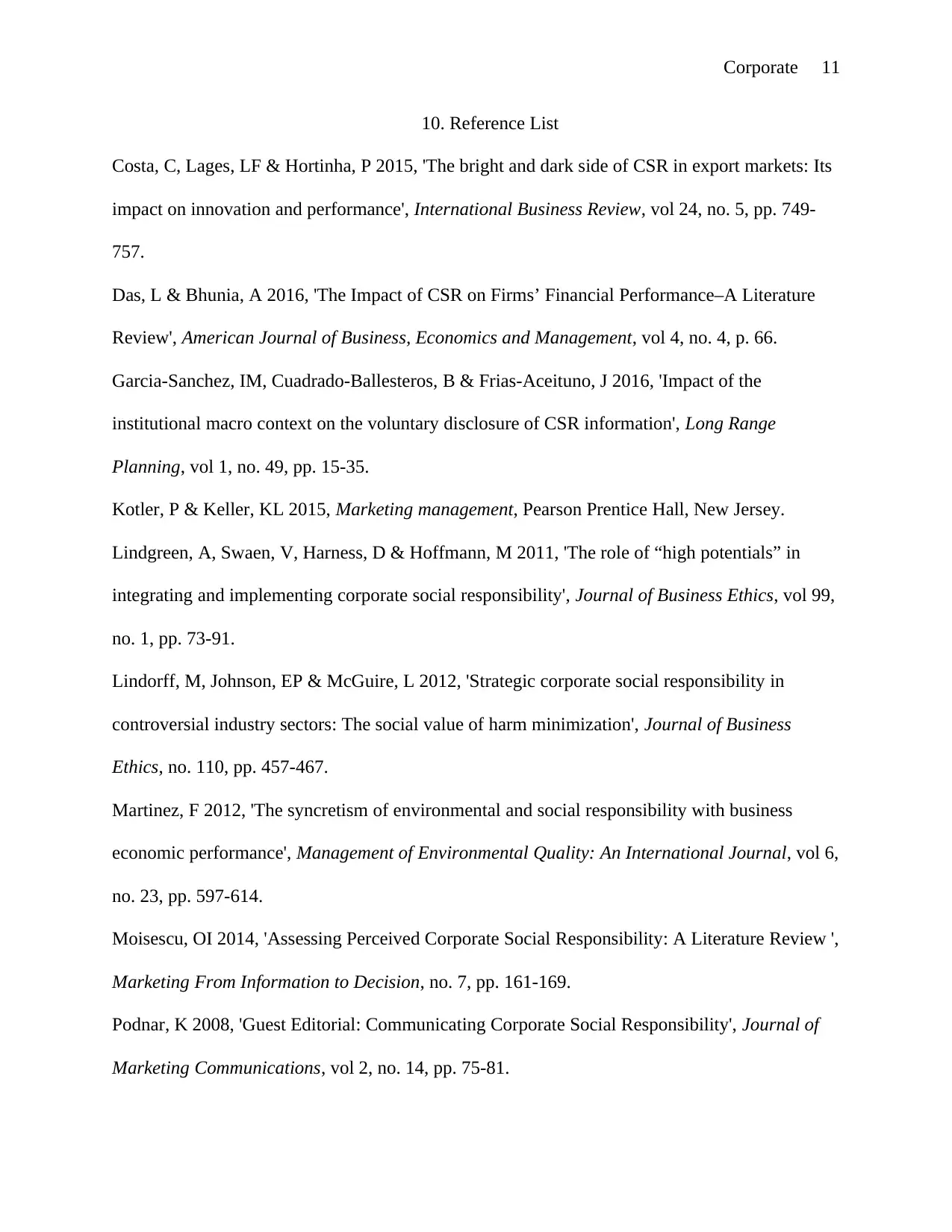
Corporate 11
10. Reference List
Costa, C, Lages, LF & Hortinha, P 2015, 'The bright and dark side of CSR in export markets: Its
impact on innovation and performance', International Business Review, vol 24, no. 5, pp. 749-
757.
Das, L & Bhunia, A 2016, 'The Impact of CSR on Firms’ Financial Performance–A Literature
Review', American Journal of Business, Economics and Management, vol 4, no. 4, p. 66.
Garcia-Sanchez, IM, Cuadrado-Ballesteros, B & Frias-Aceituno, J 2016, 'Impact of the
institutional macro context on the voluntary disclosure of CSR information', Long Range
Planning, vol 1, no. 49, pp. 15-35.
Kotler, P & Keller, KL 2015, Marketing management, Pearson Prentice Hall, New Jersey.
Lindgreen, A, Swaen, V, Harness, D & Hoffmann, M 2011, 'The role of “high potentials” in
integrating and implementing corporate social responsibility', Journal of Business Ethics, vol 99,
no. 1, pp. 73-91.
Lindorff, M, Johnson, EP & McGuire, L 2012, 'Strategic corporate social responsibility in
controversial industry sectors: The social value of harm minimization', Journal of Business
Ethics, no. 110, pp. 457-467.
Martinez, F 2012, 'The syncretism of environmental and social responsibility with business
economic performance', Management of Environmental Quality: An International Journal, vol 6,
no. 23, pp. 597-614.
Moisescu, OI 2014, 'Assessing Perceived Corporate Social Responsibility: A Literature Review ',
Marketing From Information to Decision, no. 7, pp. 161-169.
Podnar, K 2008, 'Guest Editorial: Communicating Corporate Social Responsibility', Journal of
Marketing Communications, vol 2, no. 14, pp. 75-81.
10. Reference List
Costa, C, Lages, LF & Hortinha, P 2015, 'The bright and dark side of CSR in export markets: Its
impact on innovation and performance', International Business Review, vol 24, no. 5, pp. 749-
757.
Das, L & Bhunia, A 2016, 'The Impact of CSR on Firms’ Financial Performance–A Literature
Review', American Journal of Business, Economics and Management, vol 4, no. 4, p. 66.
Garcia-Sanchez, IM, Cuadrado-Ballesteros, B & Frias-Aceituno, J 2016, 'Impact of the
institutional macro context on the voluntary disclosure of CSR information', Long Range
Planning, vol 1, no. 49, pp. 15-35.
Kotler, P & Keller, KL 2015, Marketing management, Pearson Prentice Hall, New Jersey.
Lindgreen, A, Swaen, V, Harness, D & Hoffmann, M 2011, 'The role of “high potentials” in
integrating and implementing corporate social responsibility', Journal of Business Ethics, vol 99,
no. 1, pp. 73-91.
Lindorff, M, Johnson, EP & McGuire, L 2012, 'Strategic corporate social responsibility in
controversial industry sectors: The social value of harm minimization', Journal of Business
Ethics, no. 110, pp. 457-467.
Martinez, F 2012, 'The syncretism of environmental and social responsibility with business
economic performance', Management of Environmental Quality: An International Journal, vol 6,
no. 23, pp. 597-614.
Moisescu, OI 2014, 'Assessing Perceived Corporate Social Responsibility: A Literature Review ',
Marketing From Information to Decision, no. 7, pp. 161-169.
Podnar, K 2008, 'Guest Editorial: Communicating Corporate Social Responsibility', Journal of
Marketing Communications, vol 2, no. 14, pp. 75-81.
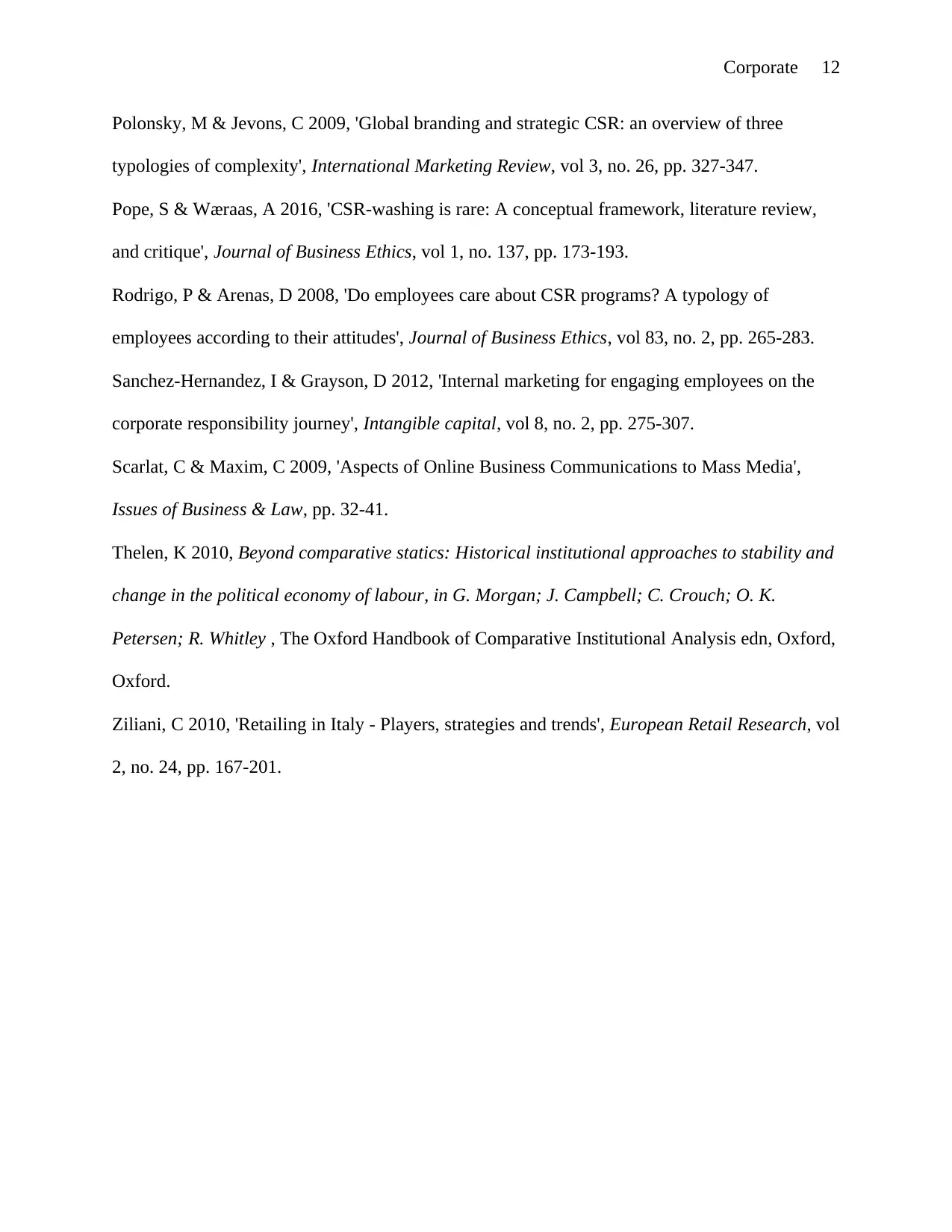
Corporate 12
Polonsky, M & Jevons, C 2009, 'Global branding and strategic CSR: an overview of three
typologies of complexity', International Marketing Review, vol 3, no. 26, pp. 327-347.
Pope, S & Wæraas, A 2016, 'CSR-washing is rare: A conceptual framework, literature review,
and critique', Journal of Business Ethics, vol 1, no. 137, pp. 173-193.
Rodrigo, P & Arenas, D 2008, 'Do employees care about CSR programs? A typology of
employees according to their attitudes', Journal of Business Ethics, vol 83, no. 2, pp. 265-283.
Sanchez-Hernandez, I & Grayson, D 2012, 'Internal marketing for engaging employees on the
corporate responsibility journey', Intangible capital, vol 8, no. 2, pp. 275-307.
Scarlat, C & Maxim, C 2009, 'Aspects of Online Business Communications to Mass Media',
Issues of Business & Law, pp. 32-41.
Thelen, K 2010, Beyond comparative statics: Historical institutional approaches to stability and
change in the political economy of labour, in G. Morgan; J. Campbell; C. Crouch; O. K.
Petersen; R. Whitley , The Oxford Handbook of Comparative Institutional Analysis edn, Oxford,
Oxford.
Ziliani, C 2010, 'Retailing in Italy - Players, strategies and trends', European Retail Research, vol
2, no. 24, pp. 167-201.
Polonsky, M & Jevons, C 2009, 'Global branding and strategic CSR: an overview of three
typologies of complexity', International Marketing Review, vol 3, no. 26, pp. 327-347.
Pope, S & Wæraas, A 2016, 'CSR-washing is rare: A conceptual framework, literature review,
and critique', Journal of Business Ethics, vol 1, no. 137, pp. 173-193.
Rodrigo, P & Arenas, D 2008, 'Do employees care about CSR programs? A typology of
employees according to their attitudes', Journal of Business Ethics, vol 83, no. 2, pp. 265-283.
Sanchez-Hernandez, I & Grayson, D 2012, 'Internal marketing for engaging employees on the
corporate responsibility journey', Intangible capital, vol 8, no. 2, pp. 275-307.
Scarlat, C & Maxim, C 2009, 'Aspects of Online Business Communications to Mass Media',
Issues of Business & Law, pp. 32-41.
Thelen, K 2010, Beyond comparative statics: Historical institutional approaches to stability and
change in the political economy of labour, in G. Morgan; J. Campbell; C. Crouch; O. K.
Petersen; R. Whitley , The Oxford Handbook of Comparative Institutional Analysis edn, Oxford,
Oxford.
Ziliani, C 2010, 'Retailing in Italy - Players, strategies and trends', European Retail Research, vol
2, no. 24, pp. 167-201.
⊘ This is a preview!⊘
Do you want full access?
Subscribe today to unlock all pages.

Trusted by 1+ million students worldwide
1 out of 13
Related Documents
Your All-in-One AI-Powered Toolkit for Academic Success.
+13062052269
info@desklib.com
Available 24*7 on WhatsApp / Email
![[object Object]](/_next/static/media/star-bottom.7253800d.svg)
Unlock your academic potential
Copyright © 2020–2025 A2Z Services. All Rights Reserved. Developed and managed by ZUCOL.





